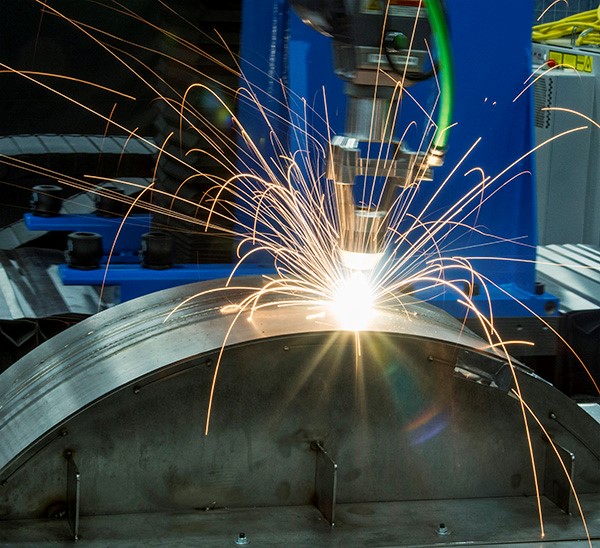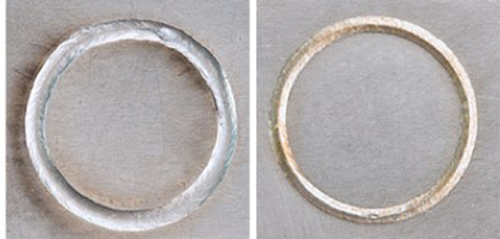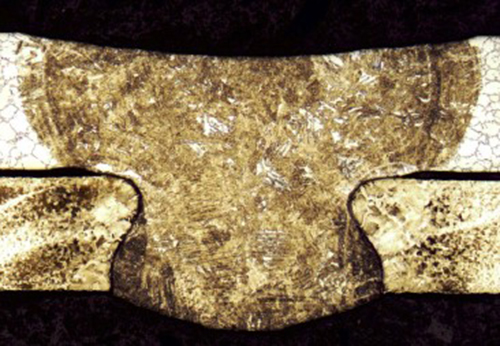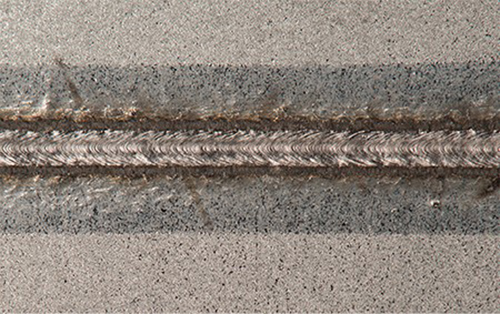The ability to design new products using different metal and alloy combinations greatly increases design and production flexibility. Optimizing a product’s finished properties, such as corrosion, wear, and heat resistance, while managing its cost, are major motivations for dissimilar metal welding.

Today’s fiber laser welding processes allow new product designs using different welded metal and alloy combinations. The process shown for an aerospace assembly produces a robust weld with an attractive cosmetic appearance. The weld doesn’t significantly change the product’s overall appearance while matching the strength of the parent material.
With successes of dissimilar metal welding have come new opportunities. Applications requiring joining of dissimilar materials have continued to grow in a number of industries including electronics, medical devices, consumer goods, automotive and aerospace.
The Challenge
Joining dissimilar materials presents some special challenges. Differences in physical and chemical properties of the metals to be welded can lead to the formation of brittle phases, cracks and residual stresses during laser welding, depending on many factors including the properties of the metals being joined, amounts of the various metals, and thermal characteristics of the weld process. The latest in this ongoing R&D effort is fiber laser welding of stainless steel to zinc-coated steel.
Fiber laser welding provides unique benefits. These include low heat input, narrow fusion and heat affected zones, with excellent mechanical properties in materials previously difficult to weld using processes that yield greater heat input to the part.
An innovative welding technique that adds quality to the welded components eliminates the undesirable weld bead end point depression which is a site for porosity, lower strength and is cosmetically unacceptable.
The results are welds that are stronger and cosmetically more attractive.
This new fiber welding process enables more effective welding of dissimilar metals. These new processes require minimal setup time and can be automated resulting in lower product cost.

Weld has an undesirable end-point depression which is a site for porosity, lower strength, and is cosmetically unacceptable. Using the latest proprietary technique, weld-point depressions are eliminated.
A Real-World Example
Because of their excellent corrosion resistance, both 304 stainless steel and zinc coated carbon steel have found widespread use in applications as diverse as kitchen appliances and aeronautical components.
Although laser welding of zinc-coated steel to austenitic stainless steel is a common practice, it can present serious problems with weld porosity. During the welding process, the energy that melts zinc coated steel and stainless steel will vaporize the zinc at approximately 900°C, which is significantly lower than the melting point of the stainless steel.
The low boiling (vaporization) point of zinc causes a vapor to form during the keyhole welding process. In seeking to escape the molten metal, the zinc vapor may become trapped in the solidifying weld pool resulting in excessive weld porosity. In some cases, the zinc vapor will escape as the metal is solidifying thereby creating blowholes or roughness of the weld surface.
Welding parameters to produce a lap joint between 304 stainless steel and galvanized zinc-coated steel have been developed. The focus of the development was to produce high quality, cosmetic welds without porosity in the weld zone and without liquid metal embrittlement cracking of the austenitic stainless steel base metal.
The result illustrated in the cross section of a typical weld shows no evidence of porosity or cracking of the dissimilar weld joints. The dark lines on each side of the weld are the gap between the stainless steel and the zinc coated steel. The gap provides a path for escape of the zinc vapor produced during welding.


Top bead of lap weld of 304 stainless steel and zinc-coated steel. Shown is the stainless steel surface.

Bottom bead (back side) of lap weld of 304 stainless steel and zinc coated steel. Shown is the steel surface.
Top and bottom surfaces of overlap weld of 0.6 mm thick 304 stainless steel and 0.5 mm thick zinc-coated steel. With proper joint design and selection of laser process parameters, cosmetic and mechanically sound welds are readily produced with no cracking, porosity, or blowholes.
Fiber Laser Welding Solutions Are Everywhere With More Coming
Laser welding shouldn’t be considered “nontraditional,” given the many applications over many years. Now with fiber laser welding, new product applications are everywhere – in electronic packages, medical devices, the vehicles we drive, the aircraft in which we fly, in process equipment, and sensors. The list is endless. Most of the earlier limitations of laser welding no longer exist or are easily overcome.
While fiber laser welding may at first be intimidating, it has been repeatedly demonstrated to enable new product designs with significant improvements in cost, quality and performance. Laser system suppliers, with available applications engineering staff, now provide turnkey solutions. That includes not only the machine but also fixturing and easily learned processing techniques.
For more information about fiber laser welding for new and improved product designs, head over to Prima Power’s website.
Filed Under: Materials • advanced




